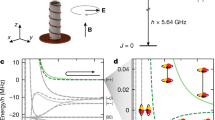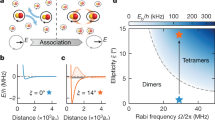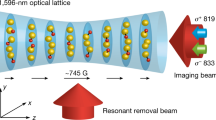Abstract
Polar molecules have a rich internal structure and long-range dipole–dipole interactions, making them useful for quantum-controlled applications and fundamental investigations. Their potential fully unfolds at ultracold temperatures, where various effects are predicted in many-body physics1,2, quantum information science3,4, ultracold chemistry5,6 and physics beyond the standard model7,8. Whereas a wide range of methods to produce cold molecular ensembles have been developed9,10,11,12,13, the cooling of polyatomic molecules (that is, with three or more atoms) to ultracold temperatures has seemed intractable. Here we report the experimental realization of optoelectrical cooling14, a recently proposed cooling and accumulation method for polar molecules. Its key attribute is the removal of a large fraction of a molecule’s kinetic energy in each cycle of the cooling sequence via a Sisyphus effect, allowing cooling with only a few repetitions of the dissipative decay process. We demonstrate the potential of optoelectrical cooling by reducing the temperature of about one million CH3F molecules by a factor of 13.5, with the phase-space density increased by a factor of 29 (or a factor of 70 discounting trap losses). In contrast to other cooling mechanisms, our scheme proceeds in a trap, cools in all three dimensions and should work for a large variety of polar molecules. With no fundamental temperature limit anticipated down to the photon-recoil temperature in the nanokelvin range, we expect our method to be able to produce ultracold polyatomic molecules. The low temperatures, large molecule numbers and long trapping times of up to 27 seconds should allow an interaction-dominated regime to be attained, enabling collision studies and investigation of evaporative cooling towards a Bose–Einstein condensate of polyatomic molecules.
This is a preview of subscription content, access via your institution
Access options
Subscribe to this journal
Receive 51 print issues and online access
$199.00 per year
only $3.90 per issue
Buy this article
- Purchase on Springer Link
- Instant access to full article PDF
Prices may be subject to local taxes which are calculated during checkout




Similar content being viewed by others
References
Góral, K., Santos, L. & Lewenstein, M. Quantum phases of dipolar bosons in optical lattices. Phys. Rev. Lett. 88, 170406 (2002)
Micheli, A., Brennen, G. K. & Zoller, P. A toolbox for lattice-spin models with polar molecules. Nature Phys. 2, 341–347 (2006)
DeMille, D. Quantum computation with trapped polar molecules. Phys. Rev. Lett. 88, 067901 (2002)
André, A. et al. A coherent all-electrical interface between polar molecules and mesoscopic superconducting resonators. Nature Phys. 2, 636–642 (2006)
Krems, R. V. Cold controlled chemistry. Phys. Chem. Chem. Phys. 10, 4079–4092 (2008)
Żuchowski, P. S. & Hutson, J. M. Low-energy collisions of NH3 and ND3 with ultracold Rb atoms. Phys. Rev. A 79, 062708 (2009)
Hinds, E. A. Testing time reversal symmetry using molecules. Phys. Scr. T 70, 34–41 (1997)
Hudson, J. J. et al. Improved measurement of the shape of the electron. Nature 473, 493–496 (2011)
Weinstein, J. D., DeCarvalho, R., Guillet, T., Friedrich, B. & Doyle, J. M. Magnetic trapping of calcium monohydride molecules at millikelvin temperatures. Nature 395, 148–150 (1998)
Gupta, M. & Herschbach, D. A mechanical means to produce intense beams of slow molecules. J. Phys. Chem. A 103, 10670–10673 (1999)
Bethlem, H. L., Berden, G. & Meijer, G. Decelerating neutral dipolar molecules. Phys. Rev. Lett. 83, 1558–1561 (1999)
Junglen, T., Rieger, T., Rangwala, S. A., Pinkse, P. W. H. & Rempe, G. Slow ammonia molecules in an electrostatic quadrupole guide. Eur. Phys. J. D 31, 365–373 (2004)
Fulton, R., Bishop, A. I. & Barker, P. F. Optical Stark decelerator for molecules. Phys. Rev. Lett. 93, 243004 (2004)
Zeppenfeld, M., Motsch, M., Pinkse, P. W. H. & Rempe, G. Optoelectrical cooling of polar molecules. Phys. Rev. A 80, 041401(R) (2009)
Ni, K.-K. et al. A high phase-space-density gas of polar molecules. Science 322, 231–235 (2008)
Shuman, E. S., Barry, J. F. & DeMille, D. Laser cooling of a diatomic molecule. Nature 467, 820–823 (2010)
Daussy et al. Limit on the parity nonconserving energy difference between the enantiomers of a chiral molecule by laser spectroscopy. Phys. Rev. Lett. 83, 1554–1557 (1999)
Hudson, E. R. et al. Production of cold formaldehyde molecules for study and control of chemical reaction dynamics with hydroxyl radicals. Phys. Rev. A 73, 063404 (2006)
Vuletić, V. & Chu, S. Laser cooling of atoms, ions, or molecules by coherent scattering. Phys. Rev. Lett. 84, 3787–3790 (2000)
Motsch, M., Zeppenfeld, M., Pinkse, P. W. H. & Rempe, G. Cavity-enhanced Rayleigh scattering. N. J. Phys. 12, 063022 (2010)
Nagy, D., Asbóth, J. K., Domokos, P. & Ritsch, H. Self-organization of a laser-driven cold gas in a ring cavity. Europhys. Lett. 74, 254–260 (2006)
Zeppenfeld, M. & Pinkse, P. W. H. Calculating the fine structure of a Fabry-Perot resonator using spheroidal wave functions. Opt. Express 18, 9580–9591 (2010)
Xuereb, A., Domokos, P., Horak, P. & Freegarde, T. Cavity cooling of atoms: within and without a cavity. Eur. Phys. J. D 65, 273–278 (2011)
Lara, M., Bohn, J. L., Potter, D., Soldán, P. & Hutson, J. M. Ultracold Rb-OH collisions and prospects for sympathetic cooling. Phys. Rev. Lett. 97, 183201 (2006)
Pritchard, D. E. Cooling neutral atoms in a magnetic trap for precision spectroscopy. Phys. Rev. Lett. 51, 1336–1339 (1983)
Narevicius, E., Bannerman, S. T. & Raizen, M. G. Single-photon molecular cooling. N. J. Phys. 11, 055046 (2009)
Riedel, J. et al. Accumulation of Stark-decelerated NH molecules in a magnetic trap. Eur. Phys. J. D 65, 161–166 (2011)
Englert, B. G. U. et al. Storage and adiabatic cooling of polar molecules in a microstructured trap. Phys. Rev. Lett. 107, 263003 (2011)
DeMille, D., Glenn, D. R. & Petricka, J. Microwave traps for cold polar molecules. Eur. Phys. J. D 31, 375–384 (2004)
Graner, G. & Guelachvili, G. Extensive high-resolution study of the crowded rovibrational CH3F spectrum around 3000 cm–1 . J. Mol. Spectrosc. 89, 19–41 (1981)
Acknowledgements
We thank P. W. H. Pinkse for help during the early stages of this experiment. Support by the Deutsche Forschungsgemeinschaft via the excellence cluster “Munich Centre for Advanced Photonics” is acknowledged.
Author information
Authors and Affiliations
Contributions
All authors contributed to the design, experimental set-up, data collection, analysis, and/or writing of the manuscript.
Corresponding author
Ethics declarations
Competing interests
The authors declare no competing financial interests.
Supplementary information
Supplementary Information
This file contains Supplementary Text 1-6, which gives a detailed description of the energy-level diagram for cooling, quantitative estimates of the transition and cooling rates, as well as a comparison between experimental data and a rate-equation model for cooling. In addition, we describe the internal-state-discriminating measurement via microwave depletion, provide additional information on the experimental setup and experimental parameters, and explain the effect of the unloading electric field strength on the measured velocity distributions. It also contains Supplementary Figures 1-6 and additional references. (PDF 1138 kb)
Rights and permissions
About this article
Cite this article
Zeppenfeld, M., Englert, B., Glöckner, R. et al. Sisyphus cooling of electrically trapped polyatomic molecules. Nature 491, 570–573 (2012). https://doi.org/10.1038/nature11595
Received:
Accepted:
Published:
Issue Date:
DOI: https://doi.org/10.1038/nature11595
This article is cited by
-
An optical tweezer array of ultracold polyatomic molecules
Nature (2024)
-
Evidence for the association of triatomic molecules in ultracold 23Na40K + 40K mixtures
Nature (2022)
-
Magneto-optical trapping and sub-Doppler cooling of a polyatomic molecule
Nature (2022)
-
A driven three-dimensional electric lattice for polar molecules
Frontiers of Physics (2022)
-
Towards chemistry at absolute zero
Nature Reviews Chemistry (2021)
Comments
By submitting a comment you agree to abide by our Terms and Community Guidelines. If you find something abusive or that does not comply with our terms or guidelines please flag it as inappropriate.



